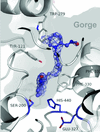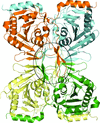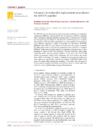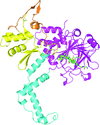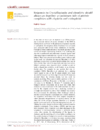issue contents
September 2015 issue

Cover illustration: The family III pectate lyase from Caldicellulosiruptor bescii with the galacturonic acid trisaccharide bound in the active site. Cartoon representation with the spectrum colours and semi-transparent surface are chosen for the protein to show off the ![[beta]](/logos/entities/beta_rmgif.gif) -helix fold. The active-site residues (cyan carbons) and the bound trisaccharide (yellow carbons) are shown as sticks and three catalytic calcium ions are shown as magenta spheres (Alahuhta et al., p. 1946).
-helix fold. The active-site residues (cyan carbons) and the bound trisaccharide (yellow carbons) are shown as sticks and three catalytic calcium ions are shown as magenta spheres (Alahuhta et al., p. 1946).
research papers
Many small-molecule compounds have been shown to bind the peripheral anionic site (PAS) of acetylcholinesterase, but only a few have been shown by X-ray crystallography to induce specific structural changes in the enzyme. Here, an unexpected conformational change observed in the PAS upon the binding of an experimental bis-imidazolium oxime nerve-agent antidote is reported and the observed structures are correlated with measured binding and reactivation kinetics.
Open  access
access
 access
accessSerial crystallography generates partial reflections from still diffraction images. Partialities are estimated with EVAL ray-tracing simulations, thereby improving merged reflection data to a similar quality as conventional rotation data.
Some interesting aspects of domain swapping, which is a unique method of protein oligomerization, are addressed, with the aim of understanding the role of interfaces and hinge regions in domain swapping.
Crystal structures of P. falciparum HAD1 in complex with three different substrates were solved in order to understand how cap-domain movement enables diverse substrate recognition by this sugar phosphatase.
The crystal structure of the 34 kDa F-actin-bundling protein ABP34 from D. discoideum is reported.
PDB reference: 34 kDa F-actin-bundling protein, 4x3n
The crystal structure of RNA polymerase I in an alternative crystal form at 5.5 Å resolution with three dimers in a pseudo-heptagonal helical arrangement is reported. The angle between the monomers in the three dimers differs markedly from that in previously reported high-resolution structures.
PDB reference: RNA polymerase I, 4ym7
The REVAN pipeline for automatic protein crystal structure solution via molecular replacement and density-guided optimization algorithms is described.
The efficiency of the Phantom Derivative method, in its non-ab initio variant, has been checked using phases obtained via molecular-replacement methods as a starting point.
Download citation


Download citation


The structural changes associated with conformational switching in a copper-sensing metalloregulator are revealed. These highlight the importance of charge distribution in regulating DNA binding.
PDB reference: CsoR, 4uig
X-ray structural analysis of T. cruzi spermidine synthase was conducted to identify novel inhibitor-binding sites, including an allosteric site, and to elucidate inhibition mechanisms.
PDB references: spermidine synthase, complex with decarboxylated S-adenosylmethionine, 4yuv; complex with trans-4-methylcyclohexylamine, 4yuw; complex with 2H-1,4-benzothiazin-3-amine, 4yux; complex with isoquinolin-1-amine, 4yuy; complex with 5-[(4-methylbenzyl)oxy]quinazoline-2,4-diamine, 4yuz; complex with N-methyl-N-phenyl-2,3-dihydro-1,4-benzodioxine-2-carboxamide, 4yu0; complex with quinolin-8-yl piperidine-1-carboxylate, 4yu1; complex with 2-phenyl-1,2-thiazol-3(2H)-one, 4yu2
High-resolution structures of a variant of an IMPDH enzyme with the regulatory CBS motifs deleted, as well as a point-mutation variant, have been solved and provide new insights into the allosteric behaviour and the octameric structure of the enzyme.
The first crystal structures of an O-demethylase methyltransferase protein in apo, THF-bound and MTHF-bound forms are reported. A conserved asparagine residue position is altered in favour of a putative proton-relay network.
Time-lapse crystal structures of human H-chain ferritin loaded with iron show the distribution of the substrate metal ion within the catalytic site. Comparison of these data with previously determined X-ray structures of R. catesbeiana M ferritin points to a number of shared and unshared features of the active sites of the two proteins that contribute to the ongoing debate on the possible existence of a universal mechanism for iron oxidation in all ferritins.
ARCIMBOLDO solves the phase problem through massive combination of small fragments and density modification. The use and performance of the single-workstation implementation is described.
ARCIMBOLDO solves the phase problem starting from small model fragments placed in the asymmetric unit. Density modification aids in combining phase information from correct solutions to avoid a combinatorial explosion of sequential searches.
The catalytic mechanism and low pH optimum of C. bescii family 3 pectate lyase are explained.
PDB references: C. bescii family 3 pectate lyase, K108A/Q111A double mutant, complex with trigalacturonic acid, 4yza; K108A/Q111N double mutant, complex with trigalacturonic acid, 4yzq; K108A/D107N double mutant, complex with trigalacturonic acid, 4yzx; K108A/E39Q double mutant, complex with trigalacturonic acid, 4yz0; K108A mutant, complex with trigalacturonic acid, 4z03; E84A mutant, 4z05; K108A/R133A double mutant, complex with α-D-galactopyranuronic acid, 4z06
Open  access
access
 access
accessThe structure of the complex of NO66 and Rpl8 was solved in the native state and NO66 recognizes the consensus motif NHXH . Tetramerization is required for efficient substrate binding and catalysis by NO66.
Models of crystal structures deposited in the Protein Data Bank for protein complexes of cisplatin and carboplatin appear to have troubling crystallographic problems and exhibit significant departures from the known principles of chemistry. They may serve as examples of what should be improved in the deposition and presentation of macromolecular models and how to handle deposition of the results of re-refinement of crystallographic data.
PDB references: cisplatin bound to a human copper chaperone (monomer), new refinement, 4ydx; cisplatin bound to a human copper chaperone (dimer), new refinement, 4yea; carboplatin binding to HEWL in NaBr crystallization conditions studied at an X-ray wavelength of 0.9163 A, new refinement, 4yem; room-temperature X-ray diffraction studies of cisplatin binding to HEWL in DMSO medium after 14 months of crystal storage, new refinement, 4yen; triclinic HEWL co-crystallized with cisplatin studied at a data-collection temperature of 150 K, new refinement, 4yeo
scientific comment
Free 

A response to the article Crystallography and chemistry should always go together: a cautionary tale of protein complexes with cisplatin and carboplatin [Shabalin et al (2015), Acta Cryst. D71, 1965–1979].
Free 

A response to the article Crystallography and chemistry should always go together: a cautionary tale of protein complexes with cisplatin and carboplatin [Shabalin et al (2015), Acta Cryst. D71, 1965–1979].
Free 

A response to the article Crystallography and chemistry should always go together: a cautionary tale of protein complexes with cisplatin and carboplatin [Shabalin et al (2015), Acta Cryst. D71, 1965–1979].


 journal menu
journal menu










